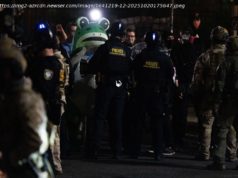Heavily militarized narrow strip at border is both tourist trap and potential flashpoint; stop comes during his first Asia visit as U. S. secretary of state
Last Updated Mar 17, 2017 3:37 AM EDT
CAMP BONIFAS, South Korea — U. S. Secretary of State Rex Tillerson visited the world’s most heavily armed border Friday, greeting U. S. soldiers on guard near the tense buffer zone between rivals North and South Korea.
He later moved on to South Korea’s capital, Seoul, for meetings with that nation’s leaders, with tensions between North Korea and the U. S. are ratcheting up.
Earliler, Tillerson touched down by helicopter at Camp Bonifas, a U. S. base about 438 yards from the Demilitarized Zone, a Cold War vestige created after the Korean War ended in 1953.
He then went to the truce village of Panmunjom inside the DMZ, a cluster of blue huts where the Korean War armistice was signed.
At one point, while Tillerson was standing on the “yellow line” that, in essence, signifies the border, three North Korean soldiers watched from their side of the line and got to within a few feet from Tillerson, pool reporters said. One of the soldiers was taking video or photos.
Tillerson is the latest in a parade of senior U. S. officials to have their photos taken at the border. But it’s the first trip by the new Trump administration’s senior diplomat as he makes a tour of Japan, South Korea and China.
Speaking in Tokyo, Tillerson earlier vowed a tougher strategy to confront North Korea’s nuclear threat. But he offered no details about what would comprise the “different approach” to North Korea the U. S. will pursue. He pointedly noted that 20 years of “diplomatic and other efforts” had failed to dissuade the isolated communist government from developing its nuclear program, which he called an “ever-escalating threat.”
The DMZ, which is both a tourist trap and a potential flashpoint, is guarded on both sides with land mines, razor wire fence, tank traps and hundreds of thousands of combat-ready troops. More than a million mines are believed to be buried inside the DMZ. Land mine explosions in 2015 that Seoul blamed on Pyongyang maimed two South Korean soldiers and led the rivals to threaten each other with attacks.
Hordes of tourists visit both sides, despite the lingering animosity. The Korean War ended with an armistice, not a peace treaty, which means the Korean Peninsula remains in a technical state of war.
President Trump is seen as seeking to examine all options — including military ones — for halting the North’s weapons programs before Pyongyang becomes capable of developing a nuclear-tipped missile that could reach the U. S. mainland.
Central to the U. S. review is China and its role in any bid to persuade Pyongyang to change course. China remains the North’s most powerful ally.
While the U. S. and its allies in Seoul and Tokyo implore Beijing to press its economic leverage over North Korea, the Chinese have emphasized their desire to relaunch diplomatic talks — a non-starter for the U. S. under current conditions.
The U. S. and China also disagree over U. S. deployment of a missile defense system to South Korea. The U. S. says it’s a system focused on North Korea. China sees it as a threat to its own security.
State Department officials have described Tillerson’s effort this week as a “listening tour” as the administration seeks a coherent North Korea policy, well-coordinated with its Asian partners.
Last week, North Korea launched four missiles into seas off Japan , in an apparent reaction to major annual military drills the U. S. is currently conducting with South Korea. Pyongyang claims the drills are a rehearsal for invasion.
In Beijing, a North Korean diplomat said Thursday that Pyongyang must act in self-defense against the drills, which he said have brought the region to the brink of nuclear war. He said the drills are aimed at using atomic weapons for a pre-emptive strike against North Korea. Washington says the maneuvers are routine and defensive.
North Korea has accelerated its weapons development, violating multiple U. N. Security Council resolutions and appearing undeterred by tough international sanctions. The North conducted two nuclear test explosions and 24 ballistic missile tests last year. Experts say it could have a nuclear-tipped missile capable of reaching the U. S. within a few years.
During last year’s election campaign, then-candidate Trump called into question U. S. security alliances and called for Tokyo and Seoul to contribute more for their defense. Tillerson, however, stressed that cooperation with Japan and South Korea was “critical.”
Japan and South Korea both host tens of thousands of U. S. troops. Washington has been urging its two allies to step up security cooperation despite their historically strained relations.
Later Friday, Tillerson was to meet in Seoul with South Korea’s acting president and his South Korean counterpart.
The last stop on his Asia trip will be Beijing, on Saturday where, says the Reuters news agency, he’s expected to firm up a U. S. visit by China’s president next month to meet Mr. Trump.






